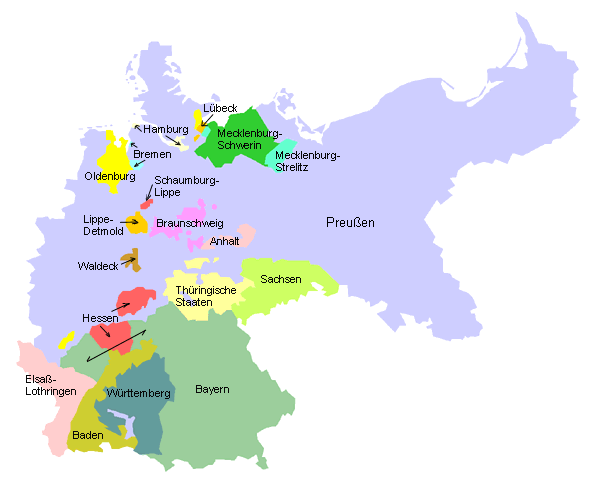Baden |
|
|
|
| Contents: | |
Baden |
|
|
|
| Contents: | |
Flags: |
||
|
||
|
||
|
||
|
||
| Meaning/Origin of the Flag: |
| The colours of Baden correspond to the colors of the former ruling dynasty of Baden, the former Margraves of Baden from the House of Zähringen. The Zähringers used a golden shield with a red eagle, the Margraves of Baden, a golden shield with a red diagonal bar. |
| Source: Volker Preuss |
| Coat of Arms: | ||
|
||
|
||
| Meaning/Origin of the Coat of Arms: |
| The coat of arms of Baden is known since the 12th century. It shows a golden shield with a red diagonal bar. The Margraves of Baden came out of the House of the Zähringers, which used a red eagle on golden background. The design of the coat of arms of Baden goes probably back to the coat of arms of the Zähringers. The division of the house into the lines of Baden-Baden (Catholic) and Baden-Durlach (Protestant), influenced not the design of the coat of arms. It was used by the two lines as small arms or heart-shield within the large, dynastic coat of arms. |
| Source by: Heraldique Europeenne |
| Federal Countries of the German Empire, 1871 to 1920 (all designations in German) |
 |
| Source: Volker Preuss |
| Numbers and Facts: |
|
|
|
|
| Source: Wikipedia (D), Der Michel |
| History: |
| 1061
· Hermann I., half-brother of the Duke of Swabia (from 1100 Duke of Zehringen, becomes
the Margrave of Verona 1112 · Hermann I., is first mentioned as Margrave of Baden, born of the House of Baden 1535–1771 · partition: 1st: Margrave County of Baden-Baden (catholic) 2nd: Margrave County of Baden-Durlach (evangelical) 1771 · extinguish of the sovereign-lineage of Baden-Baden, Baden-Durlach rules over whole Baden 1803 · Electorate of Baden 1806 · Grand Duchy of Baden 1848/49 · republican riotings 1866 · in the German War on the side of the German Confederation (Austria) 1870 · joining to the North German Federation 1871 · joining to the German Empire 1918 · fall of the monarchy, free state 1945 · partition of the country: 1st: North Baden, with parts of Wuerttemberg, => Country of Wuerttemberg-Baden, 1949–1952 federal country of the FRG 2nd: South Baden, => until 1949 Country of Baden, 1949–1952 federal country of the FRG |
| Source: Atlas zur Geschichte, Wikipedia (D), RetroLib Retrobibliothek, Discovery '97 |
| Origin of the Country's Name: |
| The name "Baden" points out to the town of Baden (Baden-Baden), namesake of the Marquisate of Baden, which appeared in the middle of the 12th century. The word "Baden" ("bath") refers to the existing hot springs there, which were already known by the Romans as a bathing place, which they called "Aquae Aureliae" (Bath of Aurelius). |
| Source: Handbuch der geographischen Namen |